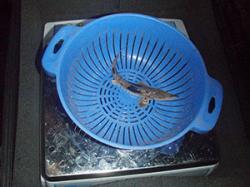 The Michigan Department of Natural Resources, together with the Little River Band of Ottawa Indians, the U.S. Fish and Wildlife Service and dedicated volunteers took on a unique project this past August to protect juvenile lake sturgeon from sea lamprey treatments conducted on the Big Manistee River.
The Michigan Department of Natural Resources, together with the Little River Band of Ottawa Indians, the U.S. Fish and Wildlife Service and dedicated volunteers took on a unique project this past August to protect juvenile lake sturgeon from sea lamprey treatments conducted on the Big Manistee River.Across Michigan, rivers are treated every few years with a chemical that aims to kill sea lamprey larvae – an invasive species that preys on salmon, trout and whitefish. The Big Manistee River is treated every three to four years in an effort to reduce sea lamprey populations.
Lake sturgeon are found in several rivers that receive these treatments, including the Big Manistee. Unfortunately, while many aquatic species are not affected by sea lamprey treatments, lake sturgeon are – particularly in the Muskegon and Manistee rivers. At those locations, lake sturgeon often die when exposed to the chemical because of the water chemistry found there.
"Unlike sea lamprey, the lake sturgeon is native to each of the Great Lakes, is very low in abundance, and is considered a threatened species," said Marty Holtgren with the DNR's Tribal Coordination Unit. "As natural resource agencies, we strive to protect this species because of its cultural, historical and ecological significance."
Biologists from the respective agencies spent time in the Big Manistee River in August, capturing the juvenile fish at night by targeting them from boats while scanning the river bottom with spotlights. Once spotted, the fish were collected with dip nets and transported to the Little River Band of Ottawa Indians' sturgeon rearing facility located on the banks of the river.
A total of 117 lake sturgeon were collected before the sea lamprey control chemical was applied and were placed in water collected from the Big Manistee River prior to the treatment. Once the chemical treatment was complete, the lake sturgeon were safely released back at the point of their capture.
"This collaboration is an example of how Great Lakes fishery management agencies are facing complex issues that balance the need to control invasive species while protecting other valuable fish species," said Corey Jerome, fisheries biologist for the Little River Band of Ottawa Indians.
Unfortunately, there was still some lake sturgeon mortality following the sea lamprey treatment as not all fish could be removed prior to the chemical application – but the mortality rate was much lower than it might have been.
For more information on lake sturgeon in Michigan, visit Michigan.gov/sturgeon.
/Note to editors: Accompanying photos are available below for download. Suggested caption information follows.
The DNR and several partners spent time in August removing juvenile lake sturgeon, like those shown here, from the Big Manistee River prior to a chemical treatment used to kill sea lamprey larvae./
The Michigan Department of Natural Resources is committed to the conservation, protection, management, use and enjoyment of the state's natural and cultural resources for current and future generations. For more information, go to www.michigan.gov/dnr.


 Advertising
Advertising